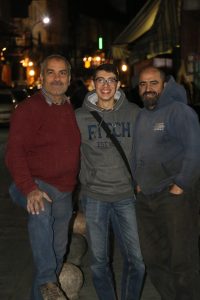Engage Diversity and Difference in Practice
Practice Behaviors:
2.1: Recognize and discuss understanding of the importance of diversity and difference in shaping life experiences in practice at the micro, mezzo, and macro levels
2.2: Discuss ways to present themselves as learners and engage clients and constituencies as experts of their own experiences
2.3: Engage in self-awareness and self-regulation to manage the influence of personal biases and values in working with diverse clients and constituencies
Diversity for me has been something that I have had the opportunity to be part of with my childhood and ethnic background. I am an Arab-American and grew up overseas as a missionary in several countries across Africa and the Middle East. In many of the countries that I lived in, I was able to interact with the local population as well as the missionaries who came from all over the world including Germany, South Korea, South Africa, the United States, and many more. In my practicum, I have been able to continue my interaction and appreciation of diversity with the clientele that Bridge Refugee Services has. For example, we currently serve clients from Sudan, Columbia, Ukraine, and Afghanistan.
Evidence 1 (Class): During Death and Dying (SOCW-250), I had the opportunity to work with several classmates to look into the ways that different cultures commemorate or celebrate death along with their rituals. The two countries that we focused on were Haiti and the Philippines and we presented this information to our classmates. We explored the ways in which funerals were conducted, how the dead are treated, and what beliefs are connected to dying. This helped us to see how traditional funerals held in the United States differs from other countries and cultures and helped to me to learn how to address clients from other backgrounds than my own. To view this presentation, please click here.
Evidence 2 (Field): One of the main ways that I have experienced diversity within my practicum experience is with clients who speak different languages. I had the opportunity to translate the English version of the Matching Grant program agreement into Arabic so that Arabic-speaking clients would have a more thorough understanding of the program requirements. To view the Arabic Match Grant Agreement form, please click here and to see the English/Arabic version of the Match Grant Agreement form, please click here.
Evidence 3 (Additional): Another way that I was able to engage in diversity was through my Social Welfare as an Institution (SOCW-212) class. During the class, we wrote a paper on the different theories about the causes of poverty and our own experiences with poverty. We also were required to interview someone who helped to shape our own belief of poverty and contrasted our current ideologies with theirs. My first experience with poverty was with people who were homeless in Yemen begging for money on the street. There was a very large population in absolute poverty and it was much more viable in Yemen than it is in the United States. This paper helped me to see another aspect of diversity: socioeconomic status. To read the paper, please click here
Skills Used: One of the main skills that I used for this competency was that of active listening since we would need to use an interpreter to communicate with clients. While the interpreter would translate what the clients would say, I would need to listen carefully to how the client said things and what their body language said to be able to communicate efficiently. I also needed to use empathy with clients to be able to understand where they were coming from and how difficult their experiences have been.
Knowledge Used: The knowledge that I used for this class was based on the multicultural experience of my task supervisor, field instructor, and my parents. Classes such as Racism and Oppression, and Human Behavior and the Social Environment helped to build my knowledge base by giving me the tools to recognize differences and learn about different cultures.
Values Presented: The value that I used for this competency was the Importance of Human Relationships. I recognized how important this value is based on clients who arrive with family members or have US ties. These connections are extremely important to clients as they adjust to life in the United States and those relationships are what help these clients thrive. The Dignity and Worth of the Person is another value that was crucial in Competency Two. Each client is a unique individual and should be treated with dignity.
Cognitive Processes Used: I was able to analyze information presented to me regarding the diversity of clients by having weekly meetings with my task supervisor and discussing the levels of diversity that clients presented. I would also evaluate my own personal feelings and judgments to help regulate myself and my actions.
Affective Processes Used: I learned how to respond and value diversity within my practicum by interacting with clients from many diverse backgrounds. Not only were clients diverse in their ethnic and racial backgrounds, but also in religious, socioeconomic class, and educational attainment. I was also able to resolve internal bias by using self-regulation and consultation to challenge unconscious bias.
Theoretical Foundation: One of the theories that I can see within my agency as well as from external sources is stereotyping. Many of our clients come from different areas of the world that many people stereotype. I was able to see how stereotyping generally relies on very limited information and is based on very little factual evidence.
